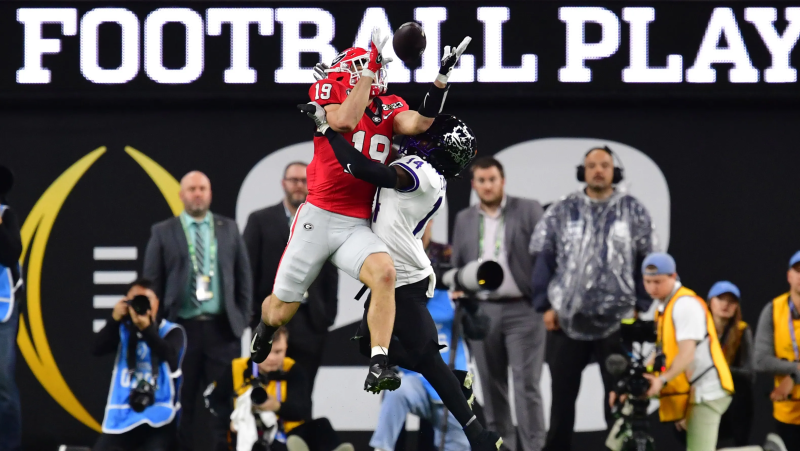Survey shows most people want college athletes to be paid. You hear that, NCAA?
When the legal threats to amateurism began to emerge about a dozen years ago, the NCAA’s main strategy was to claim that college sports would become less popular if athletes earned money.
Administrators said it repeatedly in the media. They said it in court. They even threatened to take their ball and go home if schools had to pay the athletes who help generate hundreds of millions of dollars playing college football and basketball.
And now they all need to admit that they were wrong. Historically, spectacularly, wrong.
A new national survey commissioned by Sportico in cooperation with The Harris Poll found that 67 percent of American adults believe college athletes should be paid — not just through name, image and likeness payments but in direct compensation from the school.
Further, 64 percent of those surveyed believed athletes should be able to claim status as employees, and 59 percent were in favor of college athletes being able to bargain as a union.
The numbers were relatively consistent across a variety of demographic groups. Whether man or woman, Democrat or Republican, white or Black, the notion of paying college athletes was supported by a majority of respondents. The only category registering less than 50 percent approval was respondents over the age of 58.
This is only one poll and one data point in a long-running narrative, but the trends are clear. College sports officials would be wise to pay attention.
TOP 25 RANKINGS:A closer look at every team in college football's preseason coaches poll
A similar survey conducted in 2014 by the Washington Post and ABC News found that only 33 percent supported paying college athletes, including just 24 percent of white people. So when former NCAA president Mark Emmert testified during the O’Bannon vs. NCAA trial in 2014 that paying athletes would be “tantamount to converting it into minor league sports, and we know that in the U.S., minor league sports aren’t very successful either for fan support or for the fan experience,” he had at least some data to support it.
But in the real world, there’s never been a link between the popularity of a sport and players being unable to make money.
Golf and tennis exploded across the world once they became fully professionalized. The International Olympic Committee was staunchly against including professional athletes until the 1980s. Once they opened the floodgates, the Olympics only got bigger and more popular. And even amidst all the consternation over the messy implementation of NIL in college, there’s absolutely nothing in the data from ticket sales to television ratings to suggest that fans are being turned off because the star quarterback has a nice car to drive.
It's been the same story time and time again throughout history: People like watching the games far more than they care about who’s getting paid to play them.
So perhaps former Big Ten commissioner Jim Delany was slightly out of touch when he said during the O’Bannon trial: “These games are owned by the institution, and the notion of paying athletes for participation in these games is foreign to the notion of amateurism.”
Maybe Delany and his colleagues really believed that at the time — or had convinced themselves of it — because they had spent their entire careers in the amateur model and had no other frame of reference for what college sports would look like if the athletes had the same access to large amounts of money that coaches and administrators did.
Or maybe they always knew they were full of it and used whatever rhetoric they could to preserve a dying system.
But you'd be laughed out of any room these days — and particularly a courtroom — if you tried to argue that college sports are widely consumed by the American public because players are unpaid students.
Not only is it flatly untrue, as Sportico’s poll illustrates, but it is difficult for any fair-minded American to look at the vast amounts of money flowing into college sports and not see hypocrisy in its reliance on an unpaid labor force.
We can have a good-faith argument about how sharing those revenues with college athletes would work and the variety of complications attached to things like Title IX, employment law and collective bargaining. The implementation might not be simple. But it wouldn’t offend the vast majority of fans, and it certainly wouldn’t lead to college sports turning into Triple-A baseball.
In fact, when you look at how quickly the attitudes have shifted from being pretty strongly against paying college athletes to a significant majority in favor, it likely wouldn’t be controversial at all within a few years.
The NCAA, which has built up a pretty bad track record in court trying to argue for amateurism over the last decade, simply can’t afford to ignore which way the wind is blowing on this. Even among some administrators, there is a growing resignation that revenue-sharing is the end game. Short of Congress giving the NCAA a lifeline, it’s probably the only way to end the stream of lawsuits that arise from a system that only restricts athletes’ earnings while everybody else’s go up, up and up.
If you believe that’s an important principle to preserve in the NCAA model, go right ahead. But arguing that fans will revolt if athletes get paid is now officially a talking point from the Stone Age.

Disclaimer: The copyright of this article belongs to the original author. Reposting this article is solely for the purpose of information dissemination and does not constitute any investment advice. If there is any infringement, please contact us immediately. We will make corrections or deletions as necessary. Thank you.







